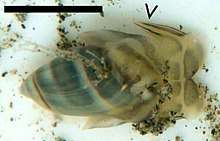Pachyoliva
Pachyoliva is a subgenus of small sea snails, marine gastropod mollusks in the genus Olivella within the family Olivellidae, the dwarf olives. Species in this subgenus inhabit soft sediments in the intertidal (or eulittoral) and subtidal (or sublittoral) zones of sandy beaches of the Panamic faunal province, that is, the west coast of the Americas from Baja California to north Peru.
| Pachyoliva | |
|---|---|
 | |
| Olivella columellaris crawling, scale bar: 1 cm. Arrowhead highlights lateral propodial appendage. From [1] | |
| Scientific classification | |
| Kingdom: | |
| Phylum: | |
| Class: | |
| (unranked): | |
| Superfamily: | |
| Family: | |
| Genus: | |
| Subgenus: | Pachyoliva Olsson, 1956[2] |
Life habits and ecology
The pachyolivas are of zoological interest for at least three reasons. First, on many beaches in their range, they are by far the most abundant macrofaunal element (= animal large enough to be easily seen),[2][3] and therefore play a key role in the food web of their habitat. Second, they have evolved a unique way of filter feeding not found in any other snail, which enables them to exploit detritus floating in the backwash as a food source.[1] Third, they utilize swash waves for locomotion by using their expanded foot as an underwater sail, a way of moving known as swash-surfing.[4]
References
- Troost, Alison I.; Rupert, Samantha D.; Cyrus, Ariel Z.; Paladino, Frank V.; Dattilo, Benjamin F.; Peters, Winfried S. (June 2012). "What can we learn from confusing Olivella columellaris and O. semistriata (Olivellidae, Gastropoda), two key species in panamic sandy beach ecosystems?". Biota Neotropica. 12 (2): 101–113. doi:10.1590/S1676-06032012000200011.
- Olsson A. A. (1956) Studies on the genus Olivella. Proceedings of the Academy of Natural Sciences of Philadelphia 108: 155-225
- Olsson A. A. (1923/24) Notes on marine molluscs from Peru and Ecuador. Nautilus 37:120-130
- Vanagt, Thomas; Vincx, Magda; Degraer, Steven (July 2008). "Can sandy beach molluscs show an endogenously controlled circatidal migrating behaviour? Hints from a swash rig experiment". Marine Ecology. 29 (Suppl. 1): 118–125. doi:10.1111/j.1439-0485.2008.00221.x.